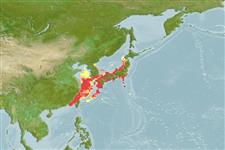इलाज़मौबरांकी (शारक और रेज़) (sharks and rays) >
Heterodontiformes (Bullhead and horn sharks) >
Heterodontidae (Bullhead, horn, or Port Jackson sharks)
Etymology: Heterodontus: heteros (Gr.), different; odontos (Gr.), tooth, referring to pointy teeth (for clutching prey) at front of jaws, different than rounded molar-like teeth (for grinding hard-shelled invertebrates) at the back. (See ETYFish); japonicus: -icus, (Gr.) belonging to: Japan, described from a collection of fishes from the seas of Japan. (See ETYFish).
More on authors: Miklouho-Maclay & Macleay.
Environment: milieu / climate zone / depth range / distribution range
पारिस्थितिकी
समुद्री ड़िमरसल; गहराई सीमा 6 - 100 m (Ref. 106604). Subtropical; 43°N - 23°N, 118°E - 143°E
Northwest Pacific: off Japan, Korean Republic, northern China including Taiwan Island.
आकार / वज़न / Age
Maturity: Lm ? range ? - ? cm
Max length : 120 cm TL पुल्लिंग / अलिंग; (Ref. 247)
Found near shore on the continental shelf, more commonly on rocky and kelp-covered bottom (Ref. 43278, 11230). Feeds on crustaceans, mollusks (including top shells), small fishes and sea urchins. Oviparous (Ref. 43278, 50449). Grabs prey by protruding its jaw with considerable distance.
Oviparous. Eggs are laid in rocks or in kelp at depths of about 8 or 9 m and are present from March through September. Eggs are more abundant, however, in March and April. Eggs are hatched in about a year; size at hatching is about 18 cm. There may be a `nest' for several females laying eggs but this is not a true nest. A female lays two eggs at a time, for 6 to 12 spawnings.
Compagno, L.J.V., 1984. FAO Species Catalogue. Vol. 4. Sharks of the world. An annotated and illustrated catalogue of shark species known to date. Part 1 - Hexanchiformes to Lamniformes. FAO Fish. Synop. 125(4/1):1-249. Rome, FAO. (Ref. 247)
IUCN Red List Status (Ref. 130435)
Threat to humans
Traumatogenic
Human uses
मात्स्यिकी: लघु वाणिज्य
अधिक जानकारी
संदर्भजलीयकृषिजलीयकृषि रूपरेखाखींचआनुवंशिकीElectrophoresesहैरेटिबिलटीबीमारीप्रक्रमणNutrientsMass conversion
सहयोगीयोतस्वीरेStamps, Coins Misc.ध्वनिसिगुयटिरारफ्तारतैरने के प्रकारगिल क्षेत्रOtolithsदिमागदृष्टि
साधन
Special reports
Download XML
इंटरनेट स्रोत
Estimates based on models
Preferred temperature (Ref.
123201): 16.6 - 23.5, mean 20.5 °C (based on 50 cells).
Phylogenetic diversity index (Ref.
82804): PD
50 = 0.5059 [Uniqueness, from 0.5 = low to 2.0 = high].
Bayesian length-weight: a=0.00380 (0.00166 - 0.00872), b=3.15 (2.95 - 3.35), in cm total length, based on LWR estimates for this (Sub)family-body shape (Ref.
93245).
Trophic level (Ref.
69278): 3.6 ±0.53 se; based on food items.
लौटाव (Ref.
120179): निम्न, न्यूनतम जनसंख्या दुगनी होने का समय 4.5 - 14 वर्ष। (Fec=12).
Fishing Vulnerability (Ref.
59153): High to very high vulnerability (72 of 100).
